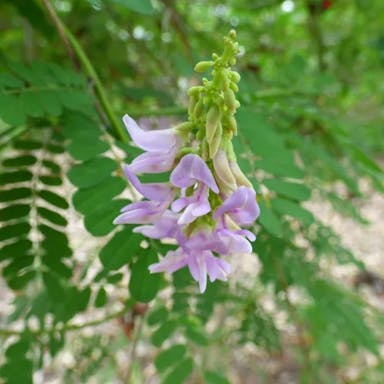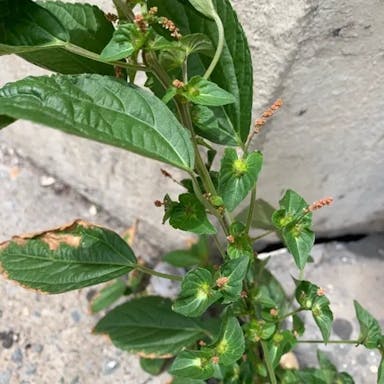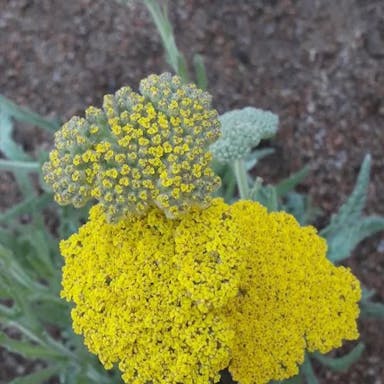Wolfsbane, also known Aconitum vulparia, perennial plant belonging buttercup family, Ranunculaceae. Native Europe found mountainous regions. Plant grows up 1 meter height has green, leaves. Flowers Aconitum vulparia bell-shaped can blue, purple, yellow. Bloom summer months known distinctive hood-like shape. Color flowers vary depending variety plant. Symbolism, Aconitum vulparia associated protection warding evil spirits. However, important note plant highly toxic handled caution. Roots leaves contain poisonous alkaloids harmful ingested even touched. Fruit, Aconitum vulparia produces capsules contain seeds. Capsules typically color found plant flowers withered. Cultivation, Aconitum vulparia prefers drained soil partial shade. Hardy plant tolerate cold temperatures, making suitable temperate climates. However, due toxicity, recommended gardens areas children pets. Overall, Aconitum vulparia unique intriguing plant striking flowers toxic properties. Important handle care respect potential dangers.
Wolfsbane
- Scientific name
- Aconitum vulparia
Basic Information
- Ranunculaceae Family Aconitum Genus Wolfsbane Species
- Ranunculaceae > Aconitum > Aconitum vulparia
- 83%
- The Completeness of This Encyclopedia
Please help us complete the encyclopedia, Terrarium is a encyclopedia service to be completed with everyone in the world. Currently, this page is 83% complete. For more information on how to contribute, please click here.
- Forb/herb
- Perennial
- Height
- 100cm ~
- Flower Color
- Leaf Color
- Anthesis
- summer
- Sunlight Exposure
Full Sun Long hours of sunlight from morning to afternoon Partial Shade A location in the shade of a tree or where either the morning or afternoon is shaded Full Shade A place where there is no direct sunlight
- Full Sun
- Hardiness Zones
This is an indicator to know to which zone each plant can winter. Knowing the zone of each plant gives you an idea of the cold temperature resistance when grown in the ground without a roof. 2: -42.7 to -40.0 3: -39.9 to -34.4 4: -34.3 to -28.9 5: -28.8 to -23.3 6: -23.2 to -17.8 7: -17.7 to -12.2 8: -12.1 to -6.7 9: -6.6 to -1.1 10: -1.0 to 4.4 11: 4.5 to 10.0
- 6
- Cold resistance
- Good
- Heat resistance
- Fair
- Habitat of origin
- Europe
- Growth Rate
- Normal
What is Wolfsbane (Aconitum vulparia)?
What is Wolfsbane (Aconitum vulparia)
Flower meaning
The flower language commonly associated with Wolfsbane in America is caution. The plant, also called Monkshood, has historically been used as a poison. Being very toxic, its link to caution is due to its poisonous nature requiring careful handling. In floral meanings, Wolfsbane signifies a warning or message of caution. It is like a reminder to be attentive of possible dangers. Encoding emotions and messages through flowers is called the language of flowers.
Calendar of Wolfsbane (Aconitum vulparia)
Calendar
Wolfsbane, scientifically known as Aconitum, is a perennial flowering plant. It typically blooms during the summer months. During this time, the flowers are at their best, displaying colors and attracting. The period usually lasts for several weeks, providing beautiful. To ensure longer, it is recommended to plant in well-drained soil with sunlight. Can also promote. However, it is important to note that contains compounds and should be handled with caution. It is advisable to wear gloves when handling and to keep out of reach and. The plant produces leaves. The flowers are blue, purple, yellow, or white. They appear in and have a shape. Some species are grown in gardens. Traditional medicine uses extracts from roots or leaves.
How to grow Wolfsbane (Aconitum vulparia)
Watering
Wolfsbane, a plant of the genus Aconitum, needs careful pouring of H2O to prosper. The perfect rate of pouring H2O for Wolfsbane is one time every 7 to 10 days during the phase of growth, which usually goes from springtime to early fall. It is important to ensure the soil is evenly damp but not waterlogged. To accomplish this, it is suggested to pour the plant deeply, giving about 1 inch (2.5 cm) of H2O per pouring session. Though, it is important to enable the soil to dry out a bit between pourings to stop root decay. During the hibernating phase, which happens in winter, pouring should be decreased to one time every 2 to 3 weeks, as the plant needs less dampness during this period. It is advisable to check the soil humidity using a dampness meter to ensure perfect pouring.
Soil and Fertilizer
Wolfsbane, known by name Aconitum, prefers loamy ground with organic stuff. The dirt should be moist but not filled with water, as too much wetness causes problems with roots. To ensure best growth, put balanced plant food with numbers 10-10-10 or 14-14-14 in early springtime, just before new leaves come out. This gives the needed nutrients for pretty leaves and flowers. The plant food should be spread at a rate of 1 to 2 pounds for every 100 square feet, all around where water drips from the plant. It's important to avoid contact between the food and the plant's stems or leaves, since this can burn them. During growing time, some nitrogen-rich plant food, like numbers 20-10-10 or 24-8-16, can be added every 4 to 6 weeks to make the plant grow strong. Regular dirt testing is a good idea to check nutrient levels and change plant food amounts correctly. Also, mulching around the plant's base with organic stuff can help keep in moisture and stop weeds from growing. Always follow the instructions on the plant food and be careful to protect yourself and nature.
Sunlight and Place
Wolfsbane, a plant commonly known as Aconitum, has specific requirements for sun exposure and amount of sunlight. The plant can withstand low temperatures, but also has a moderate heat tolerance. In terms of sunlight, Wolfsbane prefers moderate to bright indirect light. During winter, the plant can be overwintered indoors in a cool location with indirect light. Sunlight is important for growth. The plant can tolerate some direct sunlight, but too much may cause problems. It is best to place the plant where it will receive 4 to 6 hours of sunlight per day. Temperatures around 60 to 70 degrees Fahrenheit are optimal. Some shade during summer helps protect it. Overall, the right balance of sunlight and temperature is needed.
Advanced Information of Wolfsbane (Aconitum vulparia)
Pruning
Wolfsbane, scientifically known as Aconitum, is a perennial plant that benefits from pruning and cutting back regularly. Pruning is necessary to maintain plant health, promote growth, and control size and shape. It also helps to remove dead or diseased parts, improving aesthetics. The optimal time to prune Wolfsbane is late winter or early spring, before new growth begins. It is vital to wear gloves when handling Wolfsbane, as the entire plant is highly toxic. After pruning, dispose of the clippings carefully to prevent accidental ingestion. Pruning should be followed by regular care, like watering, fertilizing, and monitoring for issues. Proper care ensures the continued health of Wolfsbane.
Planting and Harvest
Wolfsbane, also known as Aconitum, is a plant commonly potted for cultivation. Potting allows better control of conditions and prevents spreading. To pot, start by choosing a 12 inch diameter pot with drainage. Fill with well-draining mix, leaving space for the root ball. Gently remove from nursery container and place in pot with root ball level with surface. Fill gaps and press lightly to secure. Water thoroughly after and place in partial shade. Repot every 2-3 years to provide fresh soil and space for growing roots. To repot, remove plant from current pot, loosen roots, and transfer to a slightly larger pot with fresh mix. Water after and continue care as usual. Improper care can lead to decline. Avoid overwatering which causes root rot. Wolfsbane prefers cool temps and may not tolerate hot, humid conditions. Monitor regularly for pests or disease and take action if needed.
Propagation
Wolfsbane, also known as Aconitum, can be propagated through various methods such as sowing seeds, division, cuttings, and leaf cuttings. To propagate through sowing seeds, collect mature seeds from the plant and sow them in a well-draining soil mix. Keep the soil moist and place the container in a warm and bright location. Germination usually takes 2-3 weeks. For division, carefully dig up the plant and separate the root clumps into smaller sections. Replant the divisions in well-prepared soil, ensuring each section has sufficient roots and shoots. Water thoroughly and provide adequate sunlight. To propagate through cuttings, take 4-6 inch stem cuttings from healthy plants. Remove the lower leaves and dip the cut end in a rooting hormone. Plant the cuttings in a well-draining soil mix and keep them moist. Place the container in a warm and bright location until roots develop. Leaf cuttings can also be used for propagation. Take healthy leaves and cut them into sections, ensuring each section has a vein. Plant the leaf sections in a well-draining soil mix, keeping them moist. Place the container in a warm and bright location until new plants emerge. Harvesting of Wolfsbane is not recommended as it is a highly toxic plant. Exercise caution and avoid contact with the plant's sap or ingestion of any plant parts.
Pests and Diseases
Wolfsbane, also known as Aconitum, suffers various pests and diseases. The common disease powdery mildew strikes Wolfsbane. The fungus Erysiphe cichoracearum triggers powdery mildew. The white powdery coating strikes leaves, stems, and flowers of the plant from powdery mildew. Powdery mildew leads to stunted growth, yellowing leaves, and withering of the plant eventually. To prevent powdery mildew, good air circulation around the plant and avoiding overhead watering are important. As a preventive measure, fungicides can be used too. Another disease crown rot strikes Wolfsbane. The fungus Phytophthora cactorum causes crown rot. Crown rot leads to rotting the crown and roots of the plant. This leads to wilting and death of the plant. To prevent crown rot, ensuring well-drained soil and avoiding overwatering are important. As a preventive measure, fungicides can be used too. Wolfsbane is also susceptible to aphid infestations. Aphids are small insects feeding on the plant's sap. This causes stunted growth, yellowing leaves, and distortion of plant parts. To prevent aphid infestations, regular monitoring of the plant and using insecticidal soaps or neem oil can be effective.
Habitat of Wolfsbane (Aconitum vulparia)
Habitat
Toxicity of Wolfsbane (Aconitum vulparia)
Health Benefits
- edible
- Inedible
- Toxic
- toxic
NO DATA
Toxic for dogs and cats
NO DATA
Q&A of Wolfsbane (Aconitum vulparia)
- Where Can I Find Wolfsbane Flowers for Sale?
Wolfsbane flowers, scientifically known as Aconitum vulparia, can be found for sale at various online gardening and plant retailers, as well as at local nurseries that specialize in herbaceous perennials. Unfortunately this plant has qualities that make it inadvisable for homeowners, so potential buyers should be cautious.
0
0
- Understanding Wild Pineapple Weed: Identification and Control?
Wild Pineapple Weed, scientifically known as Matricaria discoidea, is a common invasive plant that can be identified by its fern-like leaves and small, cone-shaped flowers that emit a pineapple-like scent when crushed. A mower before flowering enables control. Nevertheless, regeneration can occur from root fragments, so thorough removal of the root system is necessary for efficient control. On the other hand, Wolfsbane, or Aconitum vulparia, is a completely diverse plant species known for its toxic properties. It's important not to confuse the two as Wolfsbane can be harmful if ingested or touched.
0
0
- How to Care for Wolfsbane Leaves?
To care for Wolfsbane leaves, also known as Aconitum vulparia, ensure they are kept in partial to full sun and in well-draining soil. Very important watering, but avoid waterlogging as it can lead to root rot. Fertilize the plant during the growing season with a balanced fertilizer to promote healthy leaf growth. Remove any dead or damaged leaves to maintain the plant's health and appearance. Remember, Wolfsbane is highly toxic if ingested or absorbed through the skin, so always wear gloves when handling this plant.
0
0
- What Are the Uses and Risks of Wolfsbane Root?
Wolfsbane root, scientifically known as Aconitum vulparia, has been traditionally used in medicine for its analgesic and anti-inflammatory properties. Special attention from dentists is required, as incorrect ingestion results in side effects. Oral consumption leads to adverse reactions, so careful handling when cooking food containing parts of the plant is advised. Though potential medical benefits exist, misuse poses many dangers. Without expert advice, utilization carries significant risk that outweighs possible usefulness. Better to admire beautiful flowers than ingest.
0
0
- Exploring the Medicinal Benefits of Wolfsbane?
Wolfsbane, scientifically known as Aconitum vulparia, has been used in traditional medicine for its analgesic and anti-inflammatory properties. Plants grow well in humus-rich, porous, moist but well-drained soil. Partial shade is often preferred but plants tolerate full sun if the soil remains constantly moist. Division is best done in spring or fall. Leaf and stem cuttings root readily. Seeds germinate in 2 - 4 weeks at 60°F. Young seedlings transplant best. Plants are fully hardy. However, due to its high toxicity, the use of Wolfsbane must be strictly regulated. Overdose can lead to severe side effects, including heart problems and even death. Therefore, while it has potential medicinal benefits, its use should be under the supervision of a qualified healthcare professional.
0
0
- Is there a recommended way to choose Wolfsbane?
Wolfsbane, scientifically known as Aconitum vulparia, is a poisonous plant that requires careful thought when choosing kinds, seeds, and young plants. When selecting kinds, it's key to note that there are various species of Wolfsbane, each having its own characteristics. For example, one common cultivated variety has tall spikes of blue or purple flowers. Another late-blooming variety has deep purple flowers. When picking seeds, it's vital to be sure they're from a good source to guarantee quality and realness. It's also key to think about the needs of each variety, like soil type, sunlight, and moisture, to ensure germination and growth. Similarly, when getting young plants, it's key to choose healthy and strong plants. Look for young plants with well-developed root systems and firm stems. Avoid plants with yellowing or drooping leaves, as this may show poor health or disease. By carefully selecting the right variety, seeds, or young plants of Wolfsbane, you can ensure a successful and thriving garden.
0
0











